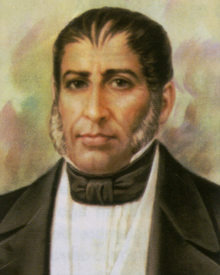Jose Joaquin de Herrera
| José Joaquín de Herrera | |
|---|---|

Portrait of José Joaquín de Herrera
|
|
|
14th President of Mexico |
|
|
In office 12 September 1844 – 21 September 1844 |
|
| Preceded by | Antonio López de Santa Anna |
| Succeeded by | Valentín Canalizo |
|
In office 6 December 1844 – 30 December 1845 |
|
| Preceded by | Valentín Canalizo |
| Succeeded by | Mariano Paredes |
|
In office 3 June 1848 – 15 January 1851 |
|
| Preceded by | Manuel de la Peña y Peña |
| Succeeded by | Mariano Arista |
| Personal details | |
| Born |
23 February 1792 Xalapa, Veracruz, Mexico |
| Died | 10 February 1854 (aged 61) Tacubaya, Mexico |
| Spouse(s) | Josefa Cortés |
José Joaquín Antonio de Herrera (23 February 1792 – 10 February 1854) was a moderate Mexican politician who served as president of Mexico three times (1844, 1844–45 and 1848–51), as well as a general in the Mexican Army during the Mexican–American War.
Herrera was born in Xalapa, Veracruz, but grew up in Perote, where his father was a postal administrator. He entered the royalist army in 1809, as a cadet in the Regiment of La Corona. By 1811, he was a captain. He fought the insurgents in Aculco, Guanajuato, Calderón, Acatlán, Veledero and other places. Later he was part of the Spanish expedition to retake Acapulco from the rebels, and he was given the military and civil command of the region.
He retired from the army in 1820 as a lieutenant colonel and moved back to Perote. There he opened a shop. In retirement, he established contacts with some of the insurgent leaders, among them Guadalupe Victoria. Shortly after the Plan de Iguala was proclaimed, a contingent of infantry moving from Veracruz to Puebla declared in favor of Agustín de Iturbide. The officers offered command to Lieutenant Colonel Herrera. He accepted and added the garrison of the Fort of San Carlos. This force marched to Orizaba, then in command of the royalists under Lieutenant Colonel Antonio López de Santa Anna. These forces also joined the Plan de Iguala.
At the time of the entrance of the Ejército Trigarante into Mexico City in 1821, Herrera was a brigadier general. However, he distanced himself from Iturbide when the latter declared himself emperor, and was arrested for conspiracy. He was freed and took part in the revolution that led to Iturbide's fall in 1823. In the new government, he received the portfolio of war (1823–24). He improved the arms of the infantry and ordered a new model saddle for the cavalry. He again held the post of minister of war in 1833 (under Santa Anna).
...
Wikipedia
